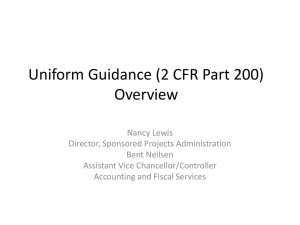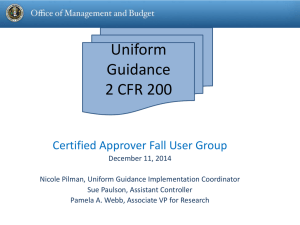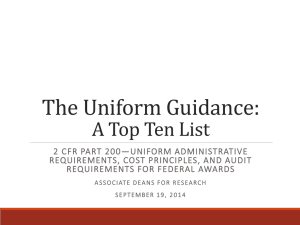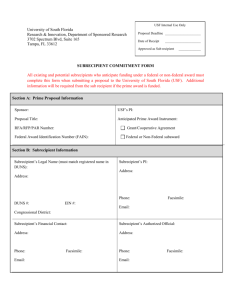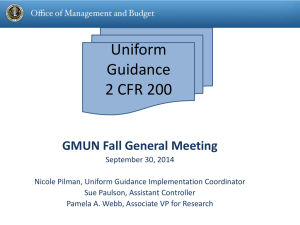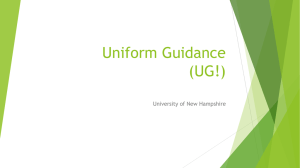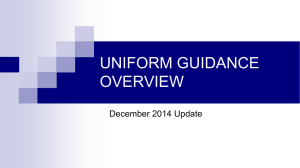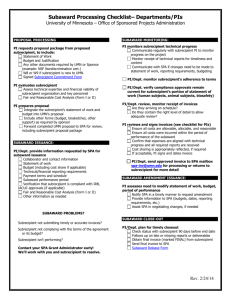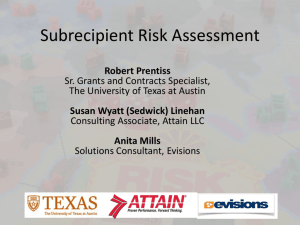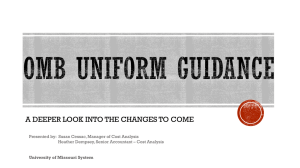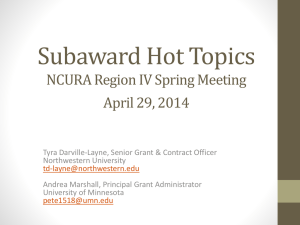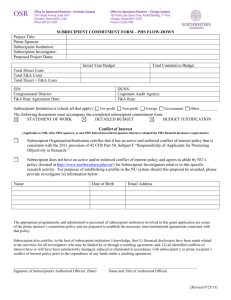OmniCircular Presentation
advertisement
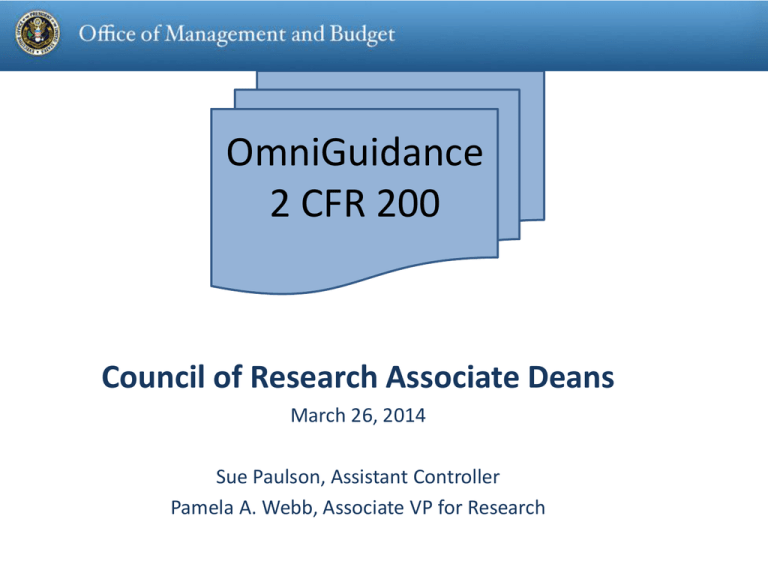
OmniGuidance 2 CFR 200 Council of Research Associate Deans March 26, 2014 Sue Paulson, Assistant Controller Pamela A. Webb, Associate VP for Research A-21 A110 A-87 2 CFR 200 A122 A-50 A133 A-89 A102 See Table of Contents Handout OmniGuidance is a combined, “simplified” version of 8 previous circulars 2 CFR 200 Subpart A – Acronyms and Definitions Subpart B – General Provisions Subpart C - Pre-award Requirements & Contents of Federal Awards Subpart D – Post Federal Award Requirements Subpart E – Cost Principles Subpart F – Audit Requirements Appendix Goals of Updated Regulations METRICS METRICS Reduce fraud, waste, and abuse METRICS METRICS METRICS METRICS METRICS vs. METRICS METRICS METRICS OmniGuidance Implementation Plan 2013 2014 12/26/13 Release 2015 12/26/14 Implementation (all but audit) 6/26/14 Agency plans due to OMB 2016 7/1/15 Audit provisions go into effect for UMN Understand (OmniGuidance) Influence Plan (OmniGuidance) Understand (Agency) Plan (Agency) Implement Evaluate Refine WHAT REGULATORY CHANGES MIGHT RESEARCHERS* CARE ABOUT? *and Research Administrators too! GOOD Funding Opportunity Announcements (FOA) • Standard minimum 60 day lead time – Minimum number of days will be 30 unless a different period is required by statute or exigent circumstances as dictated by the agency head • Announcement will be in a standard format & posted – Specified summary data – Specified full text announcement data Award Notices GOOD • Proposal application forms pre-approved by OMB • Create a unique, government-wide identifier number – “FAIN” for Federal Award Identification Number (e.g., for NIH, R01-GM123456) • Terms and conditions are spelled out – Including deliverables (reports or other) and any milestones GOOD Cost-Sharing Performance Measurement (Financial and Performance Reporting) BAD • Voluntary committed cost-sharing is not expected in research proposals • Cost-sharing obligations must be included in FOAs • Cost-sharing may not be used as a factor in the review of applications. • Stronger certification language reminds signers of statutory penalties for false certifications • Increased focus on obligation to relate progress/ performance to per-unit cost where possible – Seeking OMB FAQ to confirm that the Research Performance Progress Report (RPPR) will meet this requirement GOOD Changes in Effort Reporting • Changes are promising but not yet entirely clear – Eliminated the word “certification” – Eliminated the specific examples of methods acceptable for effort validation – Continues the flexibility that allows short term (1-2 months) fluctuations among workload categories without need to repeatedly adjust payroll – Requires that labor distribution is reasonable over the longer term and that the Recipient ensures the final amount is accurate, allowable, and properly allocated – Requires after-the-fact validation that the estimates are accurate if estimates are used up front – Charges must still be based on percentage distribution of total institutional base salary activities if time cards aren’t used – Non-exempt staff must indicate the total number of hours worked each day How can we do project certification or other approach and still comply with this requirement? UNCLEAR Conflict of Interest Requirements • New obligation for every federal agency to have COI regulations in place and require reporting for “potential” conflicts Restriction on Profit UNCLEAR – Unclear how significant an impact this will have • Recipients may received fixed price awards only if they will “realize no increment above actual cost” – Unclear if this is intended to include minor residual balances on fixed price awards MIX Subawards & Subrecipient Monitoring • F&A improvements – Sponsors (agency and pass-through) obligated to honor our negotiated F&A rate – Subrecipients (e.g., foreign, small businesses, school districts, etc.) without a negotiated rate can get an automatic 10% MTDC F&A rate • Increased burden for vendor vs. subrecipient classification – New option for each federal agency to require us to document how we decided each transaction is a subaward versus a vendor agreement • Increased burdens for subaward issuance – New obligation to obtain federal agency prior approval before using a fixed price subawards (common for foreign subs, clinical trials, and small entities) – New limit on size of fixed price subawards ($150K) – New mandatory list of data elements that have to be included in each subaward – Clarification that if you want reports from your subrecipient, you must include the requirement in your subaward – Increase in number of subrecipients without audit reports (threshold raised from $500K per year in federal expenditures to $750K) MIX Subawards & Subrecipient Monitoring (Con’t) • Increase/decrease in burden in subaward risk assessment – Pass-through entities authorized to use Federal Audit Clearinghouse to verify audit reports for single audit entities (instead of separately collecting reports or certifications) – Explicit obligation to assess risk of each potential subrecipient, with list of factors to consider • Increased subrecipient monitoring burdens – Explicit lists of mandatory and optional factors to be included in subrecipient monitoring – New obligation to be able to prove that you received/reviewed your subrecipient’s performance and financial reports GOOD Changes in Direct Costing Rules • Admin and Clerical Salaries – Can be direct charged under certain circumstances (services provided are integral to the award, specifically identified with the activity, explicitly included in the budget or have prior written approval of the Federal agency). • Protocol-Related and Data-Related Costs – Can be direct charged for developing and maintaining protocols (human, animals, etc.) managing substances, managing and securing project specific data, and coordinating research subjects • Dependent Care During Conferences Beyond the Non-Federal Entity – Can be direct charged if the entity has a consistent policy paying these costs (across all fund sources). • Entertainment Costs – Still unallowable unless it has a specific programmatic purpose and is approved in the budget or by federal agency written approval MIX Changes in Direct Costing Rules • Publication Costs (Page Charges) – Page charges are still allowable costs after award end date but before closeout (in essence, adoption of the NSF model) • Computing Devices – Devices under $5,000 may be direct charged (allocable portion only) if essential to the performance of the Federal award. • Program Income – New “default” treatment is addition (use program income for the purposes of the award and under the same terms and conditions) unless the agency specifies otherwise in its award. – Agency may treat the prime recipient differently than subrecipients if it wishes to do so – Definition now includes license fees and royalty income earned on patents and copyrights during the award period of performance • Participant Support Costs – Require prior agency approval • Conference Expenses – Now includes the concept of dissemination of technical information beyond the Recipient - so presumably within-the-U meetings don’t qualify • Visa Costs – Short-term, travel visas (as opposed to longer-term, immigration visas) are allowable costs. MIX Changes in Direct Costing Rules • Federal agencies are expected to honor negotiated F&A rates – Class or single award exceptions only when required by Federal statute or regulation, or approved by an agency head or delegate – Exceptions must be reported to OMB – Policies, procedures, and general decision-making criteria for making exceptions must be published • Entities may apply for a one-time extension to their existing F&A rates for up to 4 years – No rate change if granted • Participant Support Costs – Must be excluded from F&A (similar to NSF model) MIX Changes in Indirect /F&A Costing Rules BAD Purchasing Equipment • New data elements to track in our property system • Records must contain “use” of the equipment – COGR attempt underway to mitigate the impact of this requirement BAD • Use of statutorily imposed state or local geographical preferences prohibited in procurements • Requirement to use one of only 5 procurement methods • Language that implies that purchases over $3K require competitive quotes (potential major impact on P-cards) • Confusion not resolved about F&A on vendor purchases over $25K More … the Wonder and Worry List • Definition of program income – Now includes license fees and royalties from patents & copyrights (how to track?) • Compensation – fringe benefits – Terminal leave when an employee retires or terminates employment is allowable as indirect costs. • Implementation/Rollout – How will this be rolled out for in-progress awards versus new ones? Ones receiving incremental funding? – How will this impact our F&A rate proposal? – What resources will be needed to implement this? To abide by the new terms? UMN Implementation Planning Underway Understand • Read, share, talk, listen, absorb, interpret, compare, query, probe, evaluate • Engage, clarify, impact (OmniGuidance) – – – Influence Plan (Omni Circular) • • • • • • • • Key stakeholders (OMB, COGR, FDP, etc.) Cross-agency implementations Reinstatement of Research Terms and Conditions Organize for success Find and tackle opportunities Identify system changes Identify policy and procedure changes Identify business process changes Identify training changes Prioritize large scale opportunities Determine action plan More to come! UMN OmniGuidance Implementation OmniGuidance Steering Committee COSTING Work Group (Co-Leads) PROPERTY Work Group (Co-Leads) SUBAWARD Work Group (Co-Leads) COI Work Group (Co-Leads) HR/EFFORT Work Group (Co-Leads) PURCHASING Work Group (Co-Leads) SPECIALITY Work Group (Co-Leads) .. Others?? Work Group (Co-Leads) Pamela A. Webb Associate VP for Research pwebb@umn.edu (612) 624-1648 Sue Paulson Assistant Controller spaul@umn.edu (612) 624-5007
